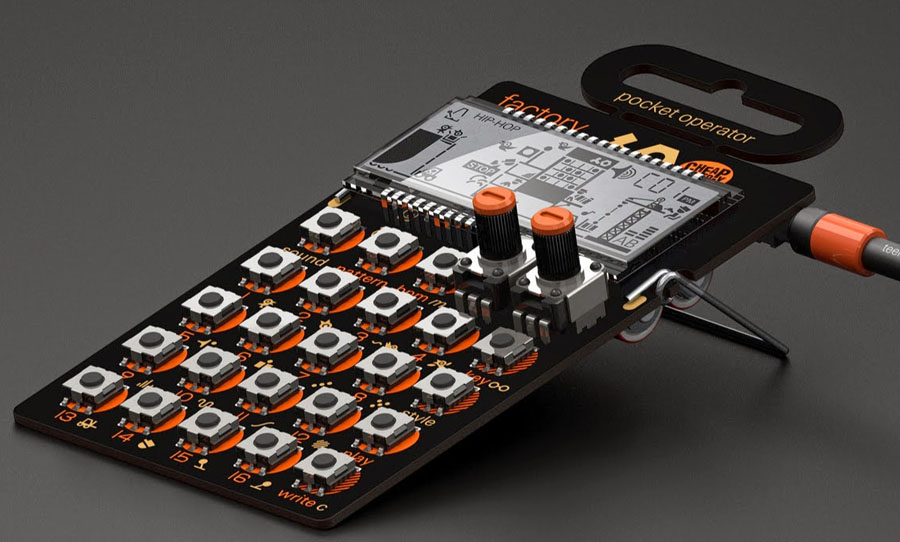Teenage Engineering is a Swedish synth manufacturer that made its debut in 2011 with the OP-1. Since then, they’ve expanded on their catalogue with a line of handheld devices called Pocket Operator. These micro synths and drum machines may look like toys, but they pack a mighty punch.
And though you may not know it, Teenage Engineering’s model for small and portable musical instruments is heavily inspired by Kraftwerk’s almost 40-year-old vision! 
Beats, bleeps and bloops in a compact handheld device. Teenage Engineering has put portable music-making in the palm of your hand with the Pocket Operator.
Pocket Operators were introduced at a time where mobile music technology and portable device culture are at the forefront of user experience. Smartphones offered third-party applications designed for music making on the go, often with sleek designs and modern sounds.
PO’s act as almost the counterbalance to this – perfect for those who enjoy music-making on the move yet want to retain the authenticity and hands-on approach to sound creation.
The original three Pocket Operators (Rhythm, Factory and Sub) were released in 2015 in collaboration with clothing brand Cheap Monday. The design philosophy? Instant fun, straight out of the box. With attention to detail and an original vision, this manufacturer sought (and continues to seek) to change the way consumers perceive and interact with musical instruments and synthesizers.
The More the Merrier
The Swedish manufacturers have engineered a series of devices that can be used solo, yet they become somewhat of an untameable beast when paired with one another. These pocket synths are modelled on various genres, styles and sounds and each one brings something unique to the table.
To date, there are 9 different models of the Pocket Operator. These include the PO-12 Rhythm, PO-14 Sub, PO-16 Factory, PO-20 Arcade, PO-24 Office, PO-28 Robot, PO-32 Tonic, PO-33 KO! and PO-35 Speak.
What binds these units together? The devices are designed to be used in tandem with one another in a similar way to Eurorack modules. Each with a different purpose, a different set of voices and varying characteristics.
These models range from synth basses and leads, to vocal samplers, to drum machines, to techno machines and so on. They can also be used in tandem with other instruments through CV and Gate functionality.
The most recent additions to the PO family expand on Teenage Engineering’s early purpose by creating powerful handheld devices with a multitude of sonic possibilities.
Take the PO-35 Speak for example. It hosts an incredible sample engine that can record on demand via an internal microphone or via a 35mm jack. Once audio has been recorded, Speak automatically quantizes and adjusts transients to each ‘step’ or ‘pad’. Users are then able to warp the sound source via the 16 onboard effects and create remarkable beats or soundscapes.
Looks Like a Calculator, Sounds Like a Synth
With a design philosophy that encourages spontaneity and a product vision of accessibility and user experience, Teenage Engineering has created a remarkable new instrument. To call it a ‘toy’ is somewhat underselling its potential, but they are just as fun.
Simplicity, affordability and ease of use are the draw cards for the POs. Insert a couple of AAA batteries into the back and setting the time and you’re on your way. Roughly the same size as your smartphone, but housing an advanced technology fostering a completely unique approach to modern music-making.
These little devices may be intended to look and feel like toys, but they have tremendous potential in experimentation with unique sounds. Take a look at this cover of Get Lucky by Daft Punk using nothing more than three Pocket Operators.
What Can These Toys Really Do?
The POs feature an exposed exterior, covering not much more than the electrical circuitry and internal wiring. The LCD screen reveals whimsical graphics – once again, reminiscent of early Nintendo games and functions as a cover for the built-in speaker and circuitry. The exposed design allows for an intuitive and compact build quality, making space for a single multiple-layer circuit board using high-quality components.
Each PO features 3.5mm input and output jacks, which function as audio ins and outs but are also used for syncing the POs. Multiple units can be synced, passing audio on one channel of the stereo in/out and sync messages on the other, which allows the whole range of POs to function as one large instrument with a single audio output.
The same inputs allow the POs to be synced with other gear that uses a pulse-based sync system, such as Korg’s Volca range.
As with their predecessors, each of these new POs offers a range of 16 sounds (or 15 synth sounds and one 16-part drum kit, in the case of the PO-28) accompanied by 16 performance-focused effects.
Each also features a 16-step sequencer, with 16 slots for saving patterns, and the new trio of POs allows up to 128 sequencer patterns to be chained together. Each features a step multiplier function too, for making beat-repeater style retriggered sounds.
Inspired by a 40-Year-Old Vision
Kraftwerk shocked the world with their futurism and tech-oriented concept album Computer World in 1981. One of the first singles from this record was Pocket Calculator. In the video below, you can see them playing bubbly lead lines and poppy melodies on handheld devices. Safe to say, this vision of the future, prophesied by the seminal German band laid the groundwork for the Pocket Operator.
Fun fact: the Casio fx-501P programmable calculator appeared on the list of ‘instruments’ used in Computer World. Kraftwerk subsequently worked in collaboration with Casio to adapt their VL-80 model calculator to double up as a fully functional synthesizer.
With a vintage design reminiscent of a bygone age of pocket arcade games, these micro hardware synth and drum machines take interactivity and user-experience back to a time of simplicity and enjoyment.
And while the jury will forever be out on whether they should be classified as ‘toys’ or ‘serious instruments’. You only have to experience the sound and functionality of a Pocket Operator to render this question irrelevant.


